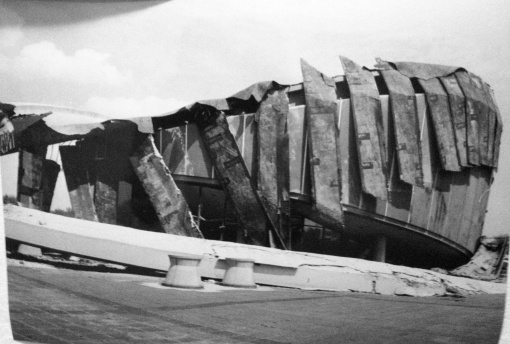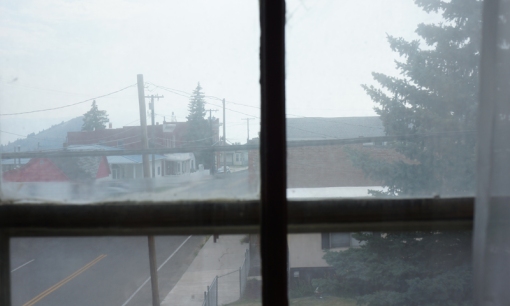
The following is the text of a talk given at a conference in Rome, Italy, on the topic “Cinema, Virtual Reality, and the Body.” In the same context I screened the 2007 Italian language film La Lunga Ombra (The Long Shadow).
I would first like to caution that despite my present title as “Distinguished Professor (retired)” I am not at all an academic or scholar. I am a self-taught artist and I suppose a contrarian “thinker.” This is by way of telling you that while I have a vague recognition of current and past academic fashions in the area of cinema, media and the wider arts, I really do not know much of the language you use. I hope you will forgive me that, but after more than 50 years of casual acquaintance with both the academic and arts world, I know fashions are transitory and quickly change. Though I have friends deeply involved in these trends, I have not followed them at all.
Our topic, “Virtual Reality, Cinema and The Body” is, in my jaded eye, a typically obtuse academic one which luckily offers a loose frame to talk about almost anything. So from that standpoint I wish to offer up an eclectic selection of observations.
 Stanza di S. Ignazio
Stanza di S. Ignazio
Here in Rome, we have a very appropriate setting for a discussion of “virtual reality” as there are many vivid historical examples of just that surrounding us: not far from here, in the historical center, on Vittorio Emmanuel, beside the Chiesa del Gesu, is the Stanza of San Ignazio – a small hallway adjacent to the modest room in which the Jesuit leader lived in the 1550’s. The hallway is a barren, barrel vaulted space. But from one central viewpoint it appears to be a well-accoutered Baroque room, with a flat coffered ceiling, statuary, and paintings and a sense of 3-dimensionality which gives the impression one could slip a hand behind the coffering. It is all a very convincing illusion: it is all painted. It was made in 1680. If you go to the end of the space, the rectangular coffers of the ceiling warp into a Baroque version of a Frank Stella painting of the 1980’s or 90’s.


 Frank Stella
Frank Stella
A walk of some blocks away from this room is his spectacular ceiling of the Chiesa di S. Ignazio, which sits on a lovely small piazza designed by another Baroque artist, Fillipo Raguzzini. Each artist, in vastly differing ways, was busy constructing a very effective “virtual reality” – in the case of Pozzo, illusionary spaces which, in a very real way, appear to exist but do not exist at all. In the case of Raguzzini, the spaces are very real, but orchestrated to shift the sensibility of those within it.


 Ceiling of Chiesa di S. Ignazio, painted by Andrea Pozzo
Ceiling of Chiesa di S. Ignazio, painted by Andrea Pozzo Piazza di S. Ignazio
Piazza di S. Ignazio
[As an aside I’d like to note that Pozzo is largely disregarded as a “painter” owing to his trickery – I in fact find him a really excellent painter in his handling of color, paint and all the rest – his skill with perspective sadly worked against him.]
Rome is littered with similar examples – from Borromini’s compressed gallery in Palazzo Spada to Bernini’s colonnade at the piazza of St Peter’s , or in the layout of certain major streets intended to compress and unite the sense of space in the city as a whole.
 Borromini’s Colonnade at Palazzo Spada
Borromini’s Colonnade at Palazzo Spada Via Quattro Fontane
Via Quattro Fontane Via del Corso
Via del Corso
Each of these cases are instances of a conscious and deliberate making of a “virtual reality.”
 S. Carlino at Quattro Fontane, by Borominni
S. Carlino at Quattro Fontane, by Borominni
The time was in the 1600-1700’s. A long time ago.

It was a time when Europe began to throw off a millennium and more of another socially imposed “virtual reality,” that of the Christian religion and the dominant Church which forced its views upon the populace of much of Europe: the Catholic Church. The Church too was a “virtual reality,” constructed of a mythic fantasy carefully calculated to psychologically appeal to an oppressed people, for whom the offer of an “eternal life” was, of course, the ultimate “virtual reality.”

 Grunewald Crucifixtion
Grunewald Crucifixtion
What can be more “virtual” than a proffered future life which does not exist?
This overturning was, I suppose ironically, visualized at the peak of the Church’s powers and celebrated in a circus of total corruption and decadence.




 Bernini sculptures
Bernini sculptures
The eruption of the art of the Renaissance is the product of that corruption. Just as in our own time we can watch the same, though sped up, in our official religion of Capitalism – a system which really began more or less at the same time when the Church started on its decline, way back in the 1600’s. In the language of the church, it was merely a shift in who the money-changers were.



 Jeff Koons, whose balloon dog recently sold for 58 million dollars, a living “artist” record
Jeff Koons, whose balloon dog recently sold for 58 million dollars, a living “artist” record
The Greeks, as seen in their temples and surviving sculptures, had a very well developed sense of perspective to be seen in the subtle shaping of the columns of the Parthenon, in the layout of the same with their various buildings shifted to enhance the spatial sense of the site.


 Acropolis and Parthenon, Athens
Acropolis and Parthenon, Athens
And in their sculpture where they played with proportion for dramatic effect. Little of their painting has survived though the glazes on their pottery give a hint of how they saw and depicted the world in two-dimensional form. Their surviving literature – in philosophy, in plays, in their mythic stories – fills out for us a sense of their way of being in the world. It is, we like to think, the foundation of “civilization.”

 Laocoon
Laocoon


Or at least “western” civilization. We tend to ignore that for some millennia before the flowering of Greek culture, the Chinese had already built a sophisticated and complex society, easily the equal of anything which flowered on the Mediterranean.


The Romans largely adopted Greek culture, though turning it from the idealized “virtual” to the hard-core “realistic” and pragmatic – which we can see in Rome’s sculpture and architecture – in the adaptation of the arch and dome as primary architectural forms – whether at the Pantheon, the Colosseo, or the remnants of aqueducts tracing their way through the landscape.







And, naturally, in their pragmatism, they developed an Empire which has left its mark throughout Europe, North Africa, and Asia. And then a funny thing happened in one of its colonies in North Africa – and Roman society was up-ended, and incrementally a new religion crept through Rome’s holdings and beyond. That religion was Christianity, and once institutionalized it bent the cultures which it invaded and utterly changed them. One can see it in the art before and after:

In Pompei (where they clearly had a grasp of perspective, and they lived their lives with a certain sensual elan).


And then the curtain of ash descended and the frolicking stopped. Just as it was shoved behind the curtain of Christianity, and Europe’s sense of itself withered behind a veil of ideological fear – while promising goodies in the never-to-be future, the Church wielded a fierce dominance over how to behave in the here and now. The medieval ages arrived. At pain of burning at the stake, as Giordano Bruno did in Campo di Fiori, and other such pleasantries, one toed the Church line or was dispatched to hell or limbo or heaven, depending on how many coins, paintings, chapels, or contributions to the construction of great churches one had given. Paranoia or justifiable fear dictated the building of towns and cities on inconvenient hill and mountain tops; it suggested walls and moats and many defensive postures, generated by the more or less constant warfare in the valleys.



Of course today tourists wax romantically about the wonderful views as they zip up the winding roads in cars and are served sumptuous meals and wine in these redoubts of utter fear. They seem never to think of what a huge chore it was to take all of life to the top of a mountain without machines and cars. It is of course interesting that on the basis of fear such beautiful things are made. Like weapons.


In the social construct of the “Dark Ages” Europe lost its sense of perspective, crushed under the sway of an all-powerful church. The earth no longer spun around the sun, which the Greeks understood . And innumerable other “virtual realities” were built and enforced. And then in the early 1000’s European culture began to slowly find its way towards what became the Renaissance. The tracings of this, and particularly in the making of what became the mathematical construction of classic visual perspective, produced a range of curious images. One of my favorite – both for its visual qualities and for its seeming philosophical contents – is Duccio’s Christ at Emmaus, a panel from his now dismembered “Maesta” altarpiece in Siena, circa 1310.

There, perched on its graphically generic for the time mountain-top sits Emmaus, its gated entrance door opening to…. Well, not very clear. Which is why I like it so much.

 La Maesta, Siena
La Maesta, Siena
While grasping at a unified perspective, but fumbling into what is a kind of early cubism, Duccio and his contemporaries seemed to sense that the organization of space wasn’t as earlier work had it, but that there was some other way of showing “reality.” Though one must wonder, as “seeing” is a highly culturized and trained phenomenon, whether in some sense Duccio actually “saw” in the manner shown in this and other works of his time.




Massaccio, a century and some later (circa 1425), hot on the footsteps of Lorenzetti’s Annuncio of 1344, and Brunelleschi’s scientific refinements of the early 1400’s, finally caught up with the Pompeians, with his Trinity in Florence.


 Massaccio, Trinity
Massaccio, Trinity
In the same period Pier Paolo Uccello experimented deeply with perspective, with his Mazzocchi drawings,


 Uccello, Mazzochi
Uccello, Mazzochi
and the panels of The Battle of San Romano, the one in London’s National Gallery being one of my favorite paintings. I imagine I have stood before this work for 20 hours, each time learning new lessons. While the painting itself minimizes its perspective nature, at the same time it seems Uccello thumbs his nose at the spectator, with the fallen soldier to the foreground left side seemingly firmly place, laying solidly on the ground. Except on a closer look he has reversed the perspective and the figure grows larger as it recedes – a trick I am certain Uccello did purposely. A little joke for the eye and brain.


Another joke was that while The Battle of San Romano celebrates the Fiorentine victory over Siena, that isn’t quite how the Sienese or history saw it: it was more or less a draw. So the illusions were compounded with a bit of propaganda.


From there on it was merely a hop, skip and a jump to the deliriums of Pozzo, and the spatial playfulness of the Baroque and Mannerist eras.
Since then, until the rupture of late 19th and early 20th century painting, the Western view hardly changed. And then, at least in painting, the unified field of traditional perspective was shattered with Cubism and related movements.
However, though painting remained culturally of interest, its public impact was overshadowed by a new medium: cinema. Here, suddenly, the old Renaissance perspective moved, and the spectator, later, with tracking shots, could move through it. Once the adjustment was made – the Lumiere’s original documentary image of a train arriving evidently scared spectators at first and they moved out of the way.
 Lumiere brothers
Lumiere brothers
Since that time, shackled to the optical nature of the camera lens which is an integral aspect of cinematic imagery, the cinema has spent well over 100 years elaborating stories (always the same stories), largely of filmed theater, and virtually always with the good old Renaissance perspective.
 Melies
Melies








In the last few decades though, digital technology has arrived at first in games with little 2D Pac-men, and now in highly detailed action games in which one can kill innumerable people from the safety of your console, all the while running through that good old 1600’s perspective.

From my viewpoint, what a fucking bore it all is –from Titanic to Avatar (same old story of the “gone native” white-guy rescuing the helpless natives) to this years’ greatly lauded film, Gravity.
 Gravity
Gravity
There, while making an interesting and intelligent use of a very sophisticated CGI technology, in which in the opening no-cuts 20 minute sequence, we float above the earth, gravity free, and the virtual camera manages to slip in and out of Point-of-View, magically sliding behind the visors of our heroes, we are still trapped in the good old Renaissance perspective, however dressed up in space. In Gravity, following its opening sequence, we are quickly hitched to the Hollywood imperatives of a really stupid story, and literally and figuratively, it is all down-hill from there and the simple-minded film crashes to earth. Though in Hollywood manner: with thrills and chills heightening into a crescendo of fear, wherein Sandra Bullock survives all obstacles and lands back on terra firma, safe and sound. Gravity requires, of course, that most essential ingredient, total suspension of disbelief. Gravity, despite the oohing and ahh’ing of most critics, should not be taken with much gravity. It is as old fashioned as any Hollywood pot-boiler, not only in its story but also in its technology of vision – yep, that tired old Renaissance perspective all decked out in outer-space. Yawn.
What would really be interesting for a shift of perspective, and is perfectly possible with the digital tools now present, would be to develop a totally new spatial sense, not based on the optics of camera lenses, nor the hide-bound rules of a 700 year old perspective system. But, alas, our directors and technicians are all totally locked into the “virtual reality” of their society, in which making things for money is the base-line value, and that requires relying on the stupidity of an audience which merely wants the same old thing again and again, albeit dressed up with new stars, slicker technology, the latest fashions – but not anything actually new that might challenge their sensibilities in a deep way. Alas.
[As an aside, I’d note that in a manner the “light artist” James Turrell is one of the artists who is actually doing interesting things not based on that old view.]



Which brings me to Plato, who talked of all of this 2,500 years ago in his fable of the cave. I don’t think I need to reiterate that story. Today we live inside a vast cave, a multi-tiered virtual reality, with people – especially younger people – enmeshed in myriad digital shadows, completely distracted and unaware of “real” things. Like how food is made, or how the society they are living in is destroying the little planet on which they live with almost everything we do. Especially with the technology with which we are so enthralled. So entranced are we with these shadows that flicker before us that we will surely die from the consequences of this distraction.
.
I have for some decades felt that our species will arrive at some point, a collectively generated “Eureka,” when indeed, courtesy of our sciences, we will have totally figured out how the world and the universe works, from the smallest to the largest, and that this point will signal our end: the tools, the thinking, the processes by which we will arrive to that Eureka point will delete us from the universe. Of course there are many ancient fables and parables which say exactly that. Our distinction will be to actually do it. We will erase ourselves with an ancient – by our standards – Greek word: hubris.


So enthralled are we with ourselves and our cleverness and intelligence, our capacity to manipulate the world to our own ends – like a video game – that we will fail to note we lack a singular and most important quality: wisdom. We are doing it now, lost in the maze of our technology, quickly doing, as many earthly “civilizations” have done before: ravaging our environment, destroying our world in our short-sighted pursuit of wealth and power. What is different now is that where once the effects were confined to local consequences, and when a Mayan or Anasazi culture collapsed, it touched only the nearby region, whereas now our pursuits and their consequences are global: the leveled forests of the Amazon, the damaged nuclear power station of Fukushima, the rapid economic and technological development of China and South East Asia and its concomitant consumption of energy and materials on a European and American “western” level, and myriad other effects of the political “globalization” of capitalism, all push us rapidly towards a global crisis which already threatens to wreak havoc on what we imagined “normal.” The full consequences are only hinted at with our concerns about “global warming” – rising sea levels, more severe weather and so on. When the real consequences unfold, the ancient fable of the Four Horsemen of the Apocalypse will charge into our “virtual reality” with a force that will make the collapse of ancient civilizations seem puny.
.
After all, we have globalized everything, and there are 7 and soon to be 9 billion humans on our planet. The coming disaster, while in good measure being orchestrated by the bytes of our digitalized world, will not be so benign and illusionary as the fleeting pixels of some grim but utterly fictional video game. It will not be virtual, but will be real. Very real.
 Albrecht Durer, The Four Horsemen of the Apocalypse
Albrecht Durer, The Four Horsemen of the Apocalypse



























































































































































































































































